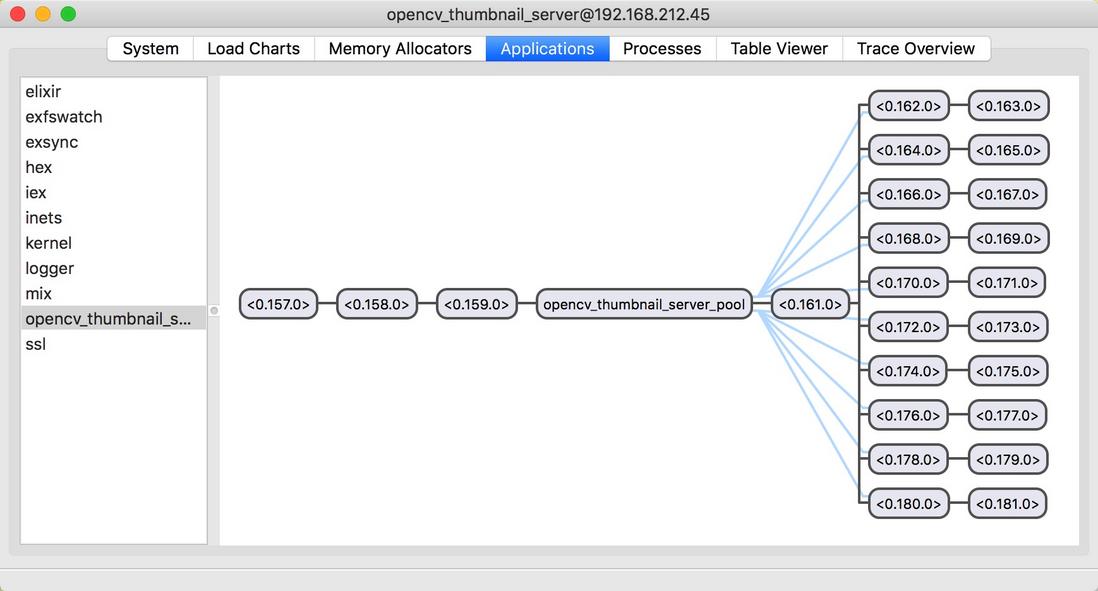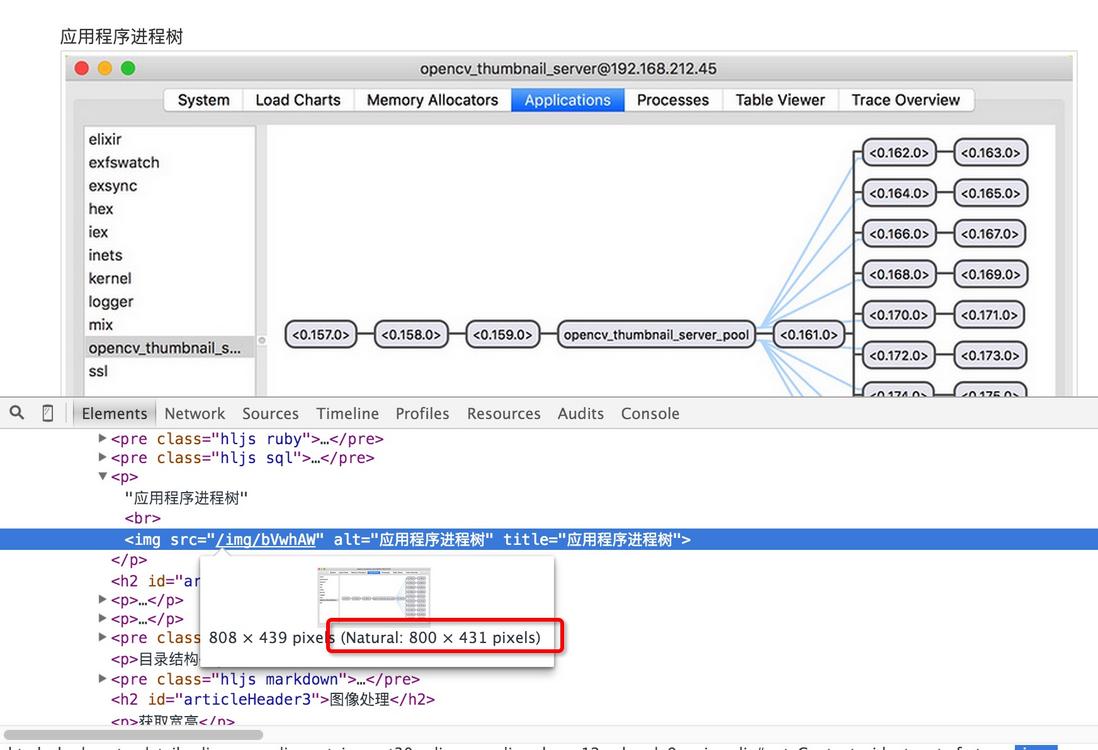Erlang/Elixir: 使用 OpenCV, Python 搭建图片缩略图服务器
脚本宝典收集整理的这篇文章主要介绍了Erlang/Elixir: 使用 OpenCV, Python 搭建图片缩略图服务器,脚本宝典觉得挺不错的,现在分享给大家,也给大家做个参考。
应用程序进程树, 默认启动 Poolboy 时, 初始化10个用于处理图片的 Python 工作进程(Worker)

首先安装OPEnCV需要的工具包
ruby -e "$(curl -fsSL https://raw.gIThubusercontent.COM/Homebrew/install/master/install)"
brew install python
brew tap homebrew/science
brew install opencv
sudo pip install numpy
sudo pip install matplotlib使用 Homebrew 的 Python 版本, 而不是 Mac OS X 系统自带的 Python
alias python='/usr/local/bin/python'创建 Elixir 项目
➜ mix new opencv_thumbnail_server --sup
* creating README.md
* creating .gitignore
* creating mix.exs
* creating config
* creating config/config.exs
* creating lib
* creating lib/opencv_thumbnail_server.ex
* creating test
* creating test/test_helper.exs
* creating test/opencv_thumbnail_server_test.exs
Your Mix PRoject was created successfully.
You can use "mix" to compile it, test it, and more:
cd opencv_thumbnail_server
mix test
Run "mix help" for more commands.Elixir 模块
@H_552_126@require LOGger
defmodule OpencvThumbnailServer do
use Application
def start(_type, _args) do
Logger.info "Start opencv thumbnail server"
OpencvThumbnailServer.Supervisor.start_link()
end
enddefmodule OpencvThumbnailServer.Supervisor do
use Supervisor
@config Application.get_env :opencv_thumbnail_server, :settings
def start_link() do
Supervisor.start_link(__MODULE__, [], name: {:global,__MODULE__})
end
def init([]) do
pool_options = @config[:poolboy]
{_, name} = pool_options[:name]
children = [
:poolboy.child_spec(name, pool_options, @config[:module_name])
]
supervise(children, strategy: :one_for_all, max_restarts: 1000, max_seconds: 3600)
end
enddefmodule OpencvThumbnailServer.Worker do
use GenServer
@config Application.get_env(:opencv_thumbnail_server, :settings)
def start_link(python_module) do
GenServer.start_link(__MODULE__, python_module, [])
end
def call_python(worker, function, args) do
GenServer.call(worker, {:call_python, function, args}, 10_000)
end
def init(python_module) do
IO.puts "Start worker"
{:ok, pid} = :python.start_link([
{:python_path, @config[:python_path]},
{:python, @config[:python]}
])
state = {python_module, pid}
{:ok, state}
end
def handle_call({:call_python, function, args}, _From, state) do
{module, pid} = state
result = :python.call(pid, module, function, args)
reply = {:ok, result}
{:reply, reply, state}
end
def handle_call(_request, _from, state) do
{:stop, :error, :bad_call, state}
end
def handle_info(_msg, {module,py_pid}) do
{:stop, :error, {module,py_pid}}
end
def terminate(_reason, {_, py_pid}) do
:python.stop(py_pid)
:ok
end
end图像处理
获取宽高
# -*- coding: utf-8 -*-
import urllib2 as urllib
import numpy as np
import cv2
def load_image_url(url):
resp = urllib.urlopen(url)
buf = resp.read()
return buf
def load_image_file(filename):
image = cv2.imdecode(filename, cv2.IMREAD_COLOR)
return image
def get_photo_sizes():
return [
[160, 160],
[320, 320],
[640, 640],
[1060, 1060],
[1280, 1280]
]
def show(buf):
# print buf
# x = cv2.imdecode(image, cv2.IMREAD_COLOR)
# d = cv2.cvtColor(c, cv2.COLOR_RGB2BGR)
np_ndarray = np.fromstring(buf, dtype=np.uint8)
x = cv2.imdecode(np_ndarray, cv2.IMREAD_UNCHANGED)
return cv2.imshow('NBA Image', x)
def write(buf):
nparray = np.fromstring(buf, dtype=np.uint8)
img = cv2.imdecode(nparray, cv2.IMREAD_UNCHANGED)
return cv2.imwrite('/tmp/imwrite.png', img)
# def get_dimension():
# url = 'http://img1.gtimg.com/16/1601/160106/16010642_1200X1000_0.jpg'
# resp = urllib.urlopen(url)
# buf = resp.read()
# x = np.fromstring(buf, dtype=np.uint8)
# img = cv2.imdecode(x, cv2.IMREAD_UNCHANGED)
# # height = np.size(img, 0)
# # width = np.size(img, 1)
# height, width = image.Shape[:2]
# return (width, height)
def get_dimension(buffer):
# 把原始的二进制图片数据转换为NpArray
nparray = np.fromstring(buffer, dtype=np.uint8)
# 把 nparray 转换为 opencv 的图像格式
image = cv2.imdecode(nparray, cv2.IMREAD_UNCHANGED)
height, width = image.shape[:2]
return (width, height)
def convert_color():
url = 'http://ww3.sinaimg.cn/mw690/6941BAEbgw1epzcuv9vmxj20me0hy0u1.jpg'
resp = urllib.urlopen(url)
buf = resp.read()
x = np.fromstring(buf, dtype=np.uint8)
img = cv2.imdecode(x, cv2.IMREAD_UNCHANGED)
if __name__ == '__main__':
get_dimension()
在 Erlang 和 Python 之间传输二进制数据
Erlang 的binary()数据类型和 Python 之间的映射关系, 在Python 2.x 中二进制数据类型为 str() 表示, Python 3.x 中为 bytes()
buf = resp.read(), 其中变量 buf 的类型为 <type 'str'>
在 Elixir 我们看到变量 buf 的值为:
{:ok, <<255, 216, 255, 224, 0, 16, 74, 70, 73, 70, 0, 1, 1, 1, 0, 72,
0, 72, 0, 0, 255, 219, 0, 67, 0, 8, 6, 6, 7, 6, 5, 8, 7, 7, 7,
9, 9, 8, 10, 12, 20, 13, 12, 11, 11, 12, 25, 18, 19, ...>>}调用 Python 函数
{:ok, data} = OpencvThumbnailServer.Api.load_image_url("https://segmentfault.com/img/bVwhAW")
OpencvThumbnailServer.Api.get_dimension(data)
{:ok, {800, 431}}创建 Python 模块
之前的 Python 图像处理模块可以组织到一个项目中单独维护. 这里使用工具 cookiecutter 创建 Python 一个基本的项目骨架, 用于实现缩略图的功能
cookiecutter 可以通过多种方式安装, 包括pip, easy_install, conda, brew
pip install cookiecutter
easy_install cookiecutter
conda install -c https://conda.binstar.org/pydanny cookiecutter
brew install cookiecutter(Mac OS X)目录结构
➜ opencv_thumbnail git:(master) tree
.
├── AUTHORS.rst
├── CONTRIBUTING.rst
├── HISTORY.rst
├── LICENSE
├── MANIFEST.in
├── Makefile
├── README.rst
├── build
│ ├── bdist.macosx-10.11-x86_64
│ └── lib
│ └── opencv_thumbnail
│ ├── __init__.py
│ └── opencv_thumbnail.py
├── dist
│ └── opencv_thumbnail-0.1.0-py2.7.egg
├── docs
│ ├── Makefile
│ ├── authors.rst
│ ├── conf.py
│ ├── contributing.rst
│ ├── history.rst
│ ├── index.rst
│ ├── installation.rst
│ ├── make.bat
│ ├── readme.rst
│ └── usage.rst
├── opencv_thumbnail
│ ├── __init__.py
│ ├── __init__.pyc
│ ├── opencv_thumbnail.py
│ └── opencv_thumbnail.pyc
├── opencv_thumbnail.egg-info
│ ├── PKG-INFO
│ ├── SOURCES.txt
│ ├── dependency_links.txt
│ ├── not-zip-safe
│ └── top_level.txt
├── requirements_dev.txt
├── SETUP.CFg
├── setup.py
├── tests
│ ├── __init__.py
│ └── test_opencv_thumbnail.py
├── tox.ini
└── travis_pypi_setup.py
9 directories, 36 filesAPI实现
调用需要从 Poolboy 池中取出一个工作进程, 并调用工作进程的call_python, 进程使用完成后返还给 Poolboy 进程池, 这里对调用过程封装一下, 以简化使用.
defmodule OpencvThumbnailServer.Api do
alias OpencvThumbnailServer.Worker
def get_dimension(data) do
worker = :poolboy.checkout(:opencv_thumbnail_server_pool)
{w, h} = Worker.call_python(worker, :get_dimension, [data])
:poolboy.checkin(:opencv_thumbnail_server_pool, worker)
{w, h}
end
def load_image_url(url) do
worker = :poolboy.checkout(:opencv_thumbnail_server_pool)
image_bin = Worker.call_python(worker, :load_image_url, [url])
:poolboy.checkin(:opencv_thumbnail_server_pool, worker)
image_bin
end
end源码
https://github.com/developerworks/opencv_thumbnail_server
参考资料
利用Python和OpenCV将URL直接转换成OpenCV格式
How to read raw png from an array in python opencv?
Install OpenCV for Python on Mac OS X
Installing scikit-image
How can i read an image from an internet url in python cv2 , scikit image and mahotas
Using Elixir, erlport with Python 2.7.9, receiving an arity error
How to read image from in memory buffer (StringIO) or from url with opencv python library
Python OpenCV convert image to byte string?
脚本宝典总结
以上是脚本宝典为你收集整理的Erlang/Elixir: 使用 OpenCV, Python 搭建图片缩略图服务器全部内容,希望文章能够帮你解决Erlang/Elixir: 使用 OpenCV, Python 搭建图片缩略图服务器所遇到的问题。
本图文内容来源于网友网络收集整理提供,作为学习参考使用,版权属于原作者。
如您有任何意见或建议可联系处理。小编QQ:384754419,请注明来意。
- 爆款游戏《贪吃蛇大作战》的 Python 实现 2019-06-09
- Linux 修改Python命令 2019-08-05
- 【python学习--小白篇】python函数中不定长参数的写法 2019-06-30
- 2013年度Python模块 2019-08-05
- 【Python】Python环境的搭建 2019-06-08
- Python线程专题纵览篇 2019-06-21
- python的一些资料和说明 2019-06-25
- Python开发环境搭建 2019-06-24
- 【Python3】Python运算符 2019-06-25
- Python学习资源 2019-06-21
- Python每日一练0030
- Py tricks(1): python实现不可修改的常量
- pyenv 安装配置与国内镜像加速 结合 virtualenv
- Win x64 +VS2013 + python2.7环境下caffe的配置学习过程
- python编程分析了一下高考那些事,发现了两个之最,原来是这样
- 为什么要学习Python?这10个理由足够了!
- python3 TypeError: unhashable type set解决方案
- 实战:从Python分析17-18赛季NBA胜率超70%球队数据开始…
- flow.ci + Github + Slack 一步步搭建 Python 自动化持续集成
- VIM自动补全插件:deoplete
